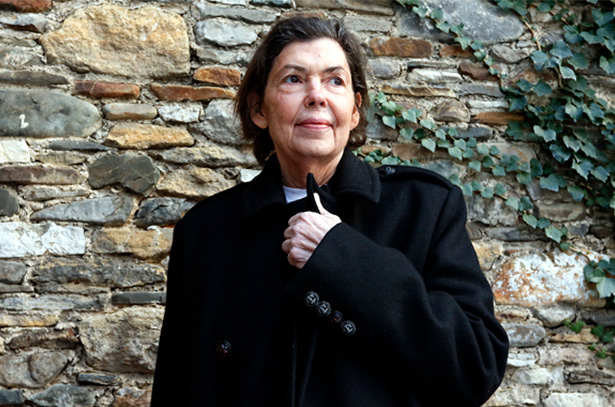
Isa Genzken
Wasserspeier and Angels
21 April - 22 May 2004
London
For over twenty years, Isa Genzken (born 1948) has created an impressive, multi-faceted body of work using a wide artistic vocabulary, an approach that includes the use of photography, video, film, collages and collage books. Genzken is best known for her sculptures, gaining attention for her minimalist oriented “Hyperbolos” and “Ellipsoids” in the late 70s and architecturally-inflected works such as her recent epoxy resin windows and skyscraper “Columns” from the 90s. Genzken’s practices, to date, are incredibly wide-ranging but her work remains dedicated to challenging the viewer’s self-awareness by means of physically altering their perceptions, bringing bodies together in spaces and integrating elements of a mixed media into sculpture.
There is an intuitive and consistent manner to Genzken’s work, not only in dramatising aspects of space and scale for the audience but in creating new dialogues and contact with surfaces of material. She has always engaged in the divides between public and private, and the effects on the modern individual of advertising, design and architecture. The socio-political content is evident and central to her oeuvre.
The formal elements of traditional sculpture are also addressed in Genzken’s work. The use of plinths to elevate works to eye-level refers to the autonomous nature she attributes to the assemblages and also to question the interface between surface and fragility. In her recent show at the Kunsthalle Zurich, a new group of works entitled Empire/Vampire, Who kills Death (2002/2003) featured twenty two sculptures using toy figures in apocalyptic scenes of war and urban devastation – a new direction in Genzken’s interest in the fictitious space of sculpture.
Hauser & Wirth are proud to present Isa Genzken’s first major solo show in London. The new works are site-specific installations created in response to the gallery space and also hint at the architecture of gothic churches. ‘Wasserspeier’ (Gargoyles) in the show’s title is Genzken’s play with the contradictory treatment of these figures gracing the church fronts. Gargoyles were originally used as waterspouts, a protective measure, and thus she toys with the irony of their visual form. The works are complex assemblages using an extensive range of media.
Isa Genzken has won numerous prizes, including the Wolfgang-Hahn-Prize, Museum Ludwig, Cologne in 2002 and the Internationaler Kunstpreis der Kulturstiftung der SSK Munchen, Munich 2003. Her show entitled “Fuck The Bauhaus/New Buildings for New York” in 2000 at the AC Project Room, New York was widely acclaimed and she gained much attention at the Documenta 11, Kassel in 2002. Her recent, successful show at the Kunsthalle Zurich (2003) included collaborative work with Wolfgang Tillmans (Catalogue available). The artist lives and works in Berlin.
About the Artist

Isa Genzken
Isa Genzken has long been considered one of Germany’s most important and influential contemporary artists. Born in Bad Oldesloe, Germany, Genzken studied at the renowned Kunstakademie Düsseldorf whose faculty at the time included Joseph Beuys, Bernd and Hilla Becher, Benjamin H.D. Buchloh and Gerhard Richter. Since the 1970s, Genzken’s diverse practice has encompassed sculpture, photography, found-object installation, film, drawing and painting. Her work borrows from the aesthetics of Minimalism, punk culture and assemblage art to confront the conditions of human experience in contemporary society and the uneasy social climate of capitalism.Genzken is best known for her sculptures, gaining attention for her minimalist oriented Hyperbolos and Ellipsoids in the late 70s, and architecturally-inflected works such as her recent epoxy resin windows and skyscraper Columns from the 90s. Genzken’s practice is incredibly wide-ranging, but her work remains dedicated to challenging the viewer’s self-awareness by means of physically altering their perceptions, bringing bodies together in spaces and integrating elements of a mixed media into sculpture.
Genzken’s totemic columns, pedestal works and collages combine disparate aspects from her many sources in seemingly nonsensical, yet harmonious sculptural compilations. These sculptures take the form of precariously stacked assemblages of potted plant designer furniture, empty shipping crates and photographs, among other things, arranged with the traditions of modernist sculpture in mind. With this cacophonous array of objects, Genzken undermines the classical notions of sculpture, re-creating the architectural dimensions of her beloved skyscrapers and the riotous colors of the city streets. Devoid of the weightiness and overpowering scale seen in the sculptures of her Minimalist predecessors, her work abandons notions of order and power, allowing the viewer to relate to the works’ inherently human qualities of fragility and vulnerability.
Inspired by the stark severity of modernist architecture and the chaotic energy of the city, Genzken’s work is continuously looking around itself, translating into three-dimensional form the way that art, architecture, design and media affects the experience of urban life, and the divides between public and private. There is an intuitive and consistent manner to Genzken’s work, not only in dramatising aspects of space and scale for the audience, but in creating new dialogues and contact with surfaces of material. The socio-political content is evident and central to her oeuvre.
In 2017, Genzken was awarded the prestigious Goslarer Kaiserring (or Emperor’s Ring) by the city of Goslar, Germany.
Current Exhibitions
1 / 12











